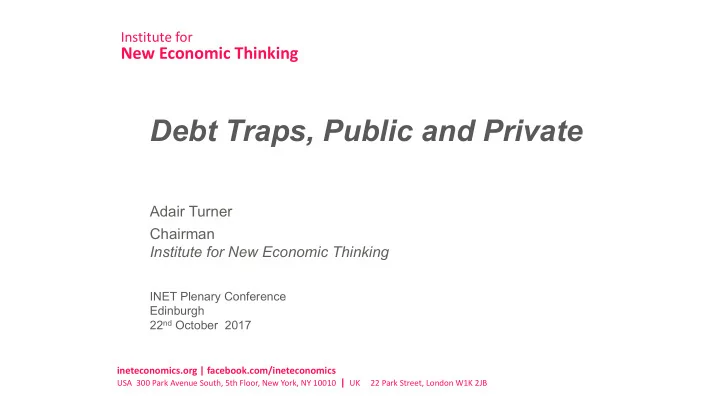

Institute for New Economic Thinking Debt Traps, Public and Private Adair Turner Chairman Institute for New Economic Thinking INET Plenary Conference Edinburgh 22 nd October 2017 ineteconomics.org | facebook.com/ineteconomics USA 300 Park Avenue South, 5th Floor, New York, NY 10010 | UK 22 Park Street, London W1K 2JB
Private domestic credit as a % of GDP: Advanced economies 1950 – 2011 Source: Financial and Sovereign Debt Crises: Some Lessons Learned and Those Forgotten , C. Reinhart & K. Rogoff, 2013 Institute for 1 New Economic Thinking
Textbook descriptions of banks and bank lending Banks take deposits of Banks lend money from money to savers and lend it ‘entrepreneurs/ to borrowers businesses’, thus allocating funds between alternative investment projects Institute for 2 New Economic Thinking
Share of real estate lending in total bank lending 60% 50% 40% Percentage 30% 20% 10% Source: “ The Great Mortgaging”, Oscar Jordá, Moritz Schularick and Alan Taylor, 2014) Institute for 3 New Economic Thinking
Japanese government and corporate debt: 1990 – 2010 Bank lending to non-financial corporates General Government debt 250 200 150 % GDP 100 50 0 1990 1991 1992 1993 1994 1995 1996 1997 1998 1999 2000 2001 2002 2003 2004 2005 2006 2007 2008 2009 2010 2011 2012 2013 2014 Source: BoJ Flow of Funds Accounts, IMF WEO database (April 2011), FSA calculations Institute for New Economic Thinking 4
Debt overhang : the unavoidable choice? Sustained low growth and low Debt erosion via inflation – debt ultra low burdens never interest rates decline But leads to new debt creation Debt write-off, default and restructuring But has disruptive / depressive effect Institute for 5 New Economic Thinking
Two policy questions How to avoid getting into this mess How to get out Institute for 6 New Economic Thinking
Categories of credit creation and nominal demand Finance of investment Stimulates nominal demand Stimulates nominal demand but Finance of consumption required just to offset impact of inequality ? • No direct stimulus to nominal demand • Could just increase credit, money balances and asset pricing Finance of existing • May stimulate demand via wealth effects asset purchase and Tobin’s Q effects • But not certainly proportional to credit created Institute for 7 New Economic Thinking
Bank lending to real estate sector and prices Japan 1981 – 1999 YoY% 60% 40% Commercial Land Price 35% 50% in the Six Major Cities 30% 40% 25% 30% 20% 20% Bank Lending to the 15% 10% Real Estate Sector (R) 10% 0% 5% -10% 0% -20% -5% -30% -10% Source: Japan Real Estate Institute; Bank of Japan; Profit Research Center Ltd; calculations by Prof. Richard Werner, Southampton University (see Princes of the Yen , Richard Werner, 2003) Institute for 8 New Economic Thinking
Credit creation for GDP transactions and nominal GDP: Japan, 1983 – 1999 YoY % YoY % 12 12 10 10 8 8 6 6 Nominal GDP 4 4 2 2 0 0 -2 -2 Cr (L) -4 -4 83 85 87 89 91 93 95 97 99 Source: Princes of the Yen , Richard Werner, 2003 Institute for 9 New Economic Thinking
Quantity theory of disaggregated credit * NOT ∆ M = ∆ P. ∆ Y Velocity of circulation stable But: ∆ C R = ∆ P R … where C R = credit to finance real estate purchase + P R = price of real estate ∆ C NR = ∆ P. ∆ Y And: … C R = credit to finance GDP transactions P = prices of current goods and services ∆ M = ∆ C R + ∆ C NR > ∆ P. ∆ Y So that: Velocity of circulation falls * See Richard Werner, New Paradigm in Macroeconomics Explaining instability and secular stagnation | 10 + Or more generally to finance existing assets
Monetary aggregates matter But not because excessive Money is a forward indicator of inflation But because excessive Credit is a forward indicator of crisis, debt overhang, post crisis depression and deflation Institute for 11 New Economic Thinking
Two policy questions How to avoid getting into this mess How to get out Institute for 12 New Economic Thinking
th 2016 Fe February 20 th 2016 Institute for 13 New Economic Thinking
Nominal GDP growth and fiscal balance 2007 – 2016 Growth of nominal Average fiscal deficit as % GDP % p.a. of GDP 2008-2016* 1.5 Eurozone 3.5 Eurozone 2.7 UK 6.5 UK 2.8 US 7.2 US (*) General government Balance, Table 1, IMF Fiscal Monitor, April 2017 Source: IMF World Economic Database, April 2017; IMF Fiscal Monitor, 2017 Institute for 14 New Economic Thinking
Two essential sources of nominal demand growth Private credit and money creation 1 Sovereign fiat money creation – now or 2 expected in the future Institute for 15 New Economic Thinking
Private credit Fiat money and money creation creation • States fail because of Free market Modern Dangerous short-term politics ensures optimal orthodoxy result • Markets efficient and Forbidden rational • Essential to deliver • Bank credit markets So dangerous that some nominal Chicago inherently inefficient banks should be demand growth and unstable abolished Plan • Can be contained by rules • Political processes can be rational Institute for New Economic Thinking 16
Recommend
More recommend